The Archos 101 XS Review: Prettier, Faster, So Much Better
by Jason Inofuentes on August 22, 2012 12:15 PM ESTDisplay
We’ll start with that most vital of tablet components, the display. We had a chance to chat with Archos ahead of this review to nail down some details about the new line. Seems that they still had several of that same 10.1” 1280x800 MVA panel, so we’re actually seeing the same display as in the G9s. We weren’t entirely dissatisfied with the G9 displays, though we did experience some poor contrast and odd viewing angles in the 101 G9 Turbo. The backlight seemed to be at fault in the contrast issue, but MVA panels should have good viewing angles so the imperfect ones we were seeing were surprising. In the XS both issues seem to have been resolved, and I suspect that has something to do with a different touch layer and backlight.
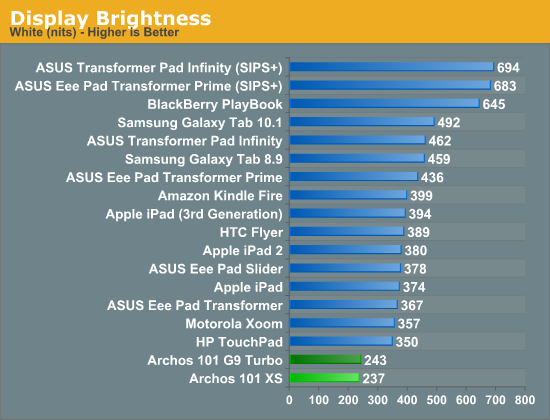
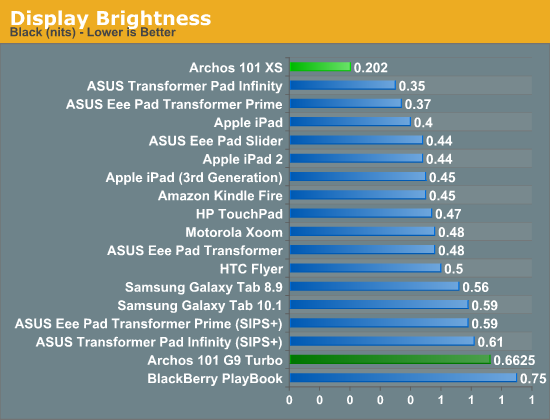

The rest of the results aren’t far off from the prior generations displays. MVA panels sacrifice brightness for good black levels and contrast. Color reproduction takes a pretty significant hit, though it’s unclear if that can’t be chocked up to software. Like the G9s then, this will suffice for watching a movie or playing a game inside, but take it outside and things could get pretty rough.
Keyboard and Accessories
The G9 Turbos hadn’t yet launched when we started hearing about Archos impossibly thin next-generation tablets, which would be a Transformer competitor with an ultra-thin keyboard dock. This, it turns out was a pretty solid rumor. I question though the validity that this is a true Transformer competitor. The Transformer’s dock creates a clamshell style device, effectively a netbook, and benefits from additional connectivity and an additional battery inside the dock. The Archos 101 XS draws from countless “keyboard cases” for the iPad and other tablets; a thin, flat keyboard with concealed magnets that match with magnets within the XS to cover the front of the device, and a mechanism for docking the XS when in use. The keyboard weighs almost nothing so there’s no weight penalty for carrying it around, but at the expense of an auxiliary battery.
I’ve got thick fingers and have never been content with anything but a standard full-sized keyboard, so I’m honestly just a poor judge of how comfortable it is to type with the XS keyboard. The keys are slightly smaller than your standard chiclet keyboard, and though the travel distance is sufficient, they feel a bit soft; it’s hard to tell when you’ve actuated the key. An assortment of Android specific keys line the top and bottom rows, and the bottom right of the device suffers some crowding in order to fit in the directional keys. The abbreviated right shift key was particularly irksome, as I consistently moved the cursor up mid sentence. After a few hours of use, I was able to get a fair amount of writing done on the keyboard, but given the option, I’d just as soon use my laptop.
The pogo pins on the XS and the exposed magnets line-up with a similar set on the keyboard dock, but the rather flat dock uses a dual-hinged flap, equipped with its own magnet, to keep the XS upright. Moving the point of contact of the flap up and down along the back of the XS gives you some control of the angle of the device, but not much. Set the XS too far back, and the pogo pins lose contact and you have to reseat the device. Weight becomes an issue, too. Though the XS is quite light, it is still much heavier than the dock, so the combination is top heavy and sits precariously on a lap.
Fans of Archos are no doubt saddened at the loss of their beloved kickstand, but fear not. There are two other accessories planned for release not long after the XS debuts. Both will utilize the pogo pins on the bottom of the device, and take the form of media stands. The first is a complete solution with speakers while the other will be similar but with an audio out so users can connect their own speakers. I expected that Archos wouldn’t sacrifice the kickstand without offering something in return; and as someone that’s been known to watch streaming content on a tablet as I move from room to room in my house, the concept of having a few well placed docks scattered around the house seems perfectly plausible.


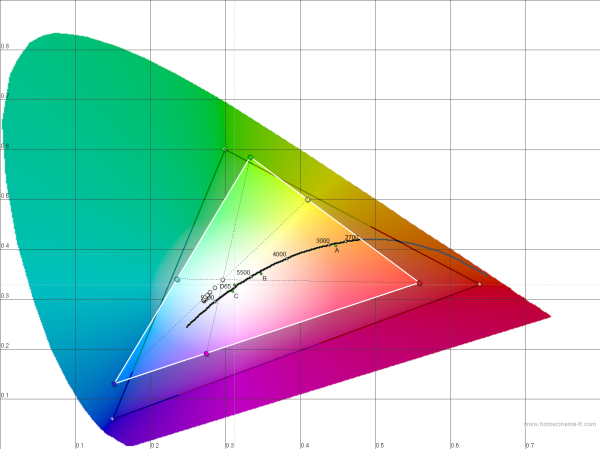
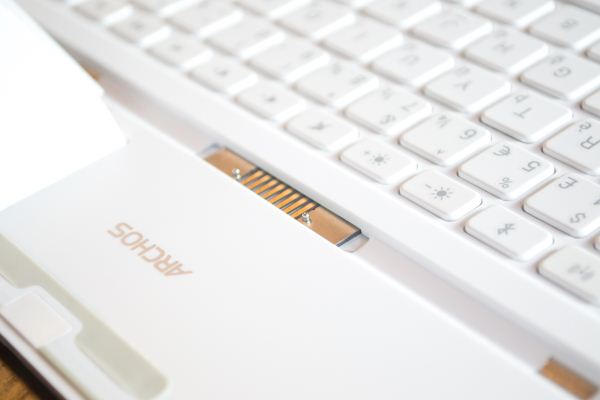
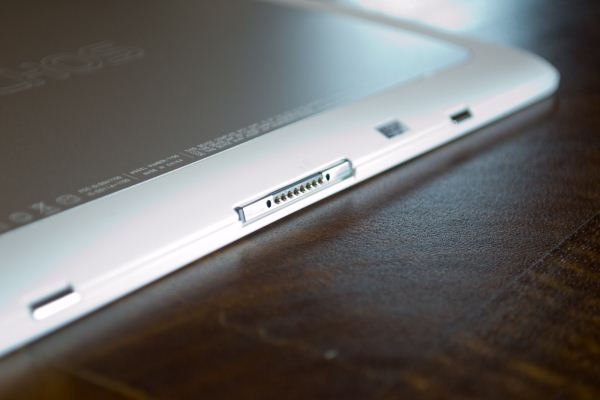
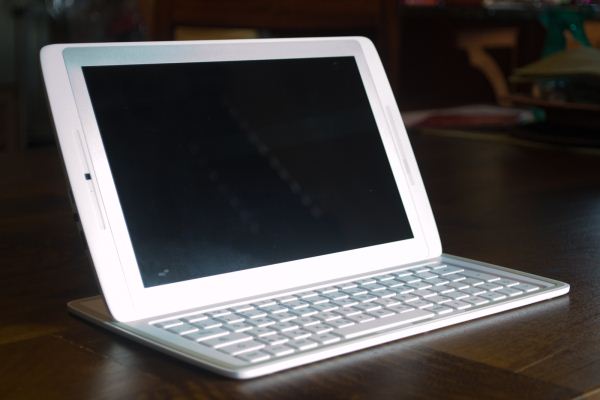








44 Comments
View All Comments
Chaitanya - Wednesday, August 22, 2012 - link
Like my previous comments about Lite-On and Plextor, Archos also seems to be exploring new technologies in order to sustain business. I am sure many of the previous archos users surely will miss the old video players when portable players meant either buying an iPod or other MP3 players which only played music and had tiny storage with grey scale displays.PubFiction - Friday, August 24, 2012 - link
You forgot to mention that Archos and Rio pretty much invented the MP3 player that apple would copy. Thats kind how it works though, sadly they never had the advertising budget to both show off what they had before anyone else or to secure the supplies to put together the best hardware. Big companies like apple, MS and google just nab up the ideas of the real innovators and then get all the credit.tbutler - Friday, August 24, 2012 - link
Nope, sorry. I had a Rio 500, a Nomad Jukebox, an Archos Jukebox, and a first-gen iPod, and this is dead wrong.The Rio was cute, and the interface wasn't a handicap given the capacity, but the capacity was simply anemic - with the largest-capacity SmartMedia card, you could store maybe 2-3 albums' worth of music on it, and you had to explicitly switch between internal and card storage.. a real pain. So not terribly useful.
The Nomad Jukebox, which came out before the Archos and iPod, fixed the capacity issue... but the browsing interface was utterly atrocious, and the only way I found it usable was to build playlists on the computer and just run them from the Jukebox. It was also huge even at the time, larger and heavier than contemporary portable CD players, with a tiny and hard-to-read screen in the center.
The Archos Jukebox was at least browsable on the device, but all music had to be user-managed through a user-created folder structure; no way to use ID3 tags to browse, no shuffle play across folders, and playlists limited to .M3U files stored in the folder hierarchy. The hardware was better than the Nomad, but still chunky, heavy, difficult to pocket (the plastic endcaps were a problem, see the pic accompanying my review at the time - http://www.tidbits.com/resources/592/archos-jukebo... and trying to swap the batteries was a nightmare.
The iPod couldn't browse a user folder hierarchy, but in all other ways was immeasurably superior - easy and quick to ID3 browse with the scroll wheel, good display for the time, easily pocketable. No surprise why it ate everyone else's lunch.
tbutler - Friday, August 24, 2012 - link
Sigh, looks like the URL got messed up; try http://www.tidbits.com/resources/592/archos-jukebo... without the end parenthesis.Zak - Monday, August 27, 2012 - link
Wasn't Creative Nomad before Archos and Rio? I had a small Nomad that used Smart Media memory cards. It was the coolest thing ever. And I'm pretty sure Archos and Rio came after.vishwa108 - Wednesday, August 22, 2012 - link
It is sad that fanboys like these are allowed to roam amok within the hallowed halls of Anandatech. Archos is not only a pretender to the throne of The Emperor of The New Clothes, it is The One who has, in recent memory, left a trail of unrequiteness and whose genetics has morphed into this state of hypnotism. Witness and learn what a minor chosen one could do as it scales the Peak of Choseness with nary a conscience other than mutterings of the variable tongue to its hapless and mesmerised victims.StormyParis - Wednesday, August 22, 2012 - link
Say what ?Namey - Wednesday, August 22, 2012 - link
I agreemattmc61 - Wednesday, August 22, 2012 - link
I didn't think LSD was still around.N4g4rok - Wednesday, August 22, 2012 - link
I post like that raising the issue of over-embellishing. Interesting.